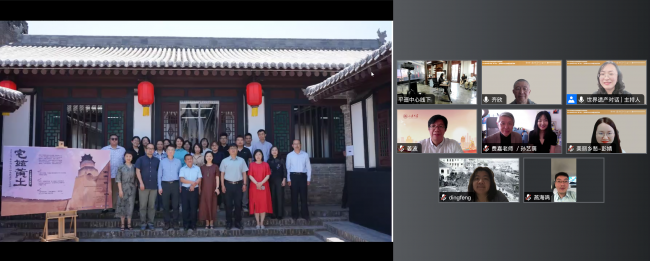| 2023 World Heritage Dialogue Session 2: Public Communication and Education of the Living Heritage |
| PublishDate:2023-08-15 Hits:2713 |
June 10 is China’s Cultural and Natural Heritage Day. On this day, the second session of the 2023 World Heritage Dialogue series – “Public Communication and Education of the Living Heritage” – was held in Pingyao, China. This session was co-hosted by the College of Architecture and Urban Planning (CAUP) of Tongji University, WHITRAP Shanghai, ICOMOS China, and Pingyao County Party Committee & Government, and co-organised by Ruan Yisan Cultural Heritage Conservation and Inheritance Research Centre (Pingyao) and Shanghai Tongji Urban Planning & Design Institute Co. Ltd (TJUPDI).
This event invited experts and senior practitioners from various fields, including heritage conservation, heritage education, heritage communication, and the children’s book industry, to engage in an interdisciplinary dialogue focusing on the public communication and education of living heritage, as it relates to the philosophy, methods and pathways to promote public participation, especially the participation of teenagers and children, in heritage conservation. The event lasted three hours, integrating both the virtual platform (Tencent Meeting) and the offline Pingyao venue. The live stream was offered on WeChat and Bilibili, attracting more than 4,600 real-time viewers.
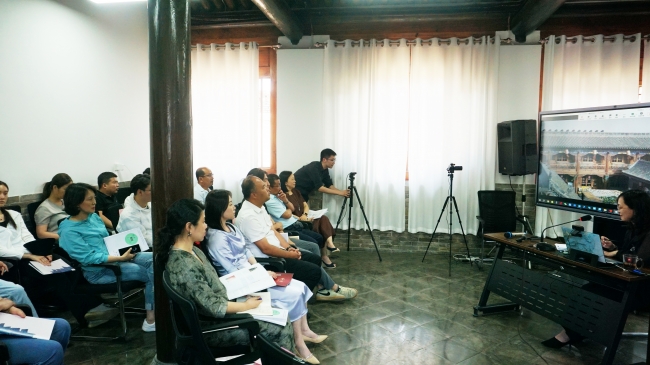 Pingyao venue
01 | Welcome Speeches
At the beginning of the event, Liu Zhen, a Programme Specialist at WHITRAP Shanghai, introduced the event and speakers. Professor Shao Yong from CAUP and the Executive Director of WHITRAP Shanghai, and Wang Yan, a Member of the Standing Committee of the Pingyao Party Committee and Minister of Communication of Pingyao County Government, respectively delivered welcome speeches on behalf of the dialogue’s organizers.
Prof. Shao Yong introduced the activities of the World Heritage Dialogue series, which were jointly initiated by CAUP and WHITRAP Shanghai in celebration of the 50th Anniversary of the World Heritage Convention in 2022. She also introduced “Imagining Heritage – I Grew Up in Pingyao”, a heritage promotion project that was initiated in 2019 through the joint efforts of Tongji University, Pingyao County Government and a group of young artists. The project features the creation of a series of pictorial books for children. She noted that as the public nature of cultural heritage and the public’s interest in heritage conservation are gradually becoming a common consensus, Tongji University has been actively exploring mechanisms and pathways for the public to participate in heritage conservation over the past decade, in addition to promoting international cooperation and exchanges mainly involving experts. These efforts have given impetus to the creative transformation and innovative development of China’s traditional culture and contributed to the continuous revitalisation of cultural heritage.
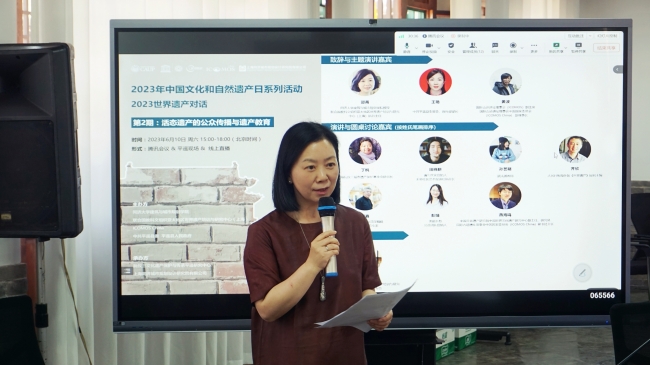 Prof. Shao Yong giving speech
Wang Yan gave a brief introduction to the Ruan Yisan Cultural Heritage Conservation and Inheritance Research Centre (Pingyao). She noted that the centre was jointly established by the Pingyao Party Committee and the County Government and Tongji University in 2021 as Pingyao’s proactive measure to explore ways to preserve cultural heritage based on its World Heritage City status, as well as a meaningful attempt to promote traditional culture and strengthen cultural confidence. Wang then reviewed the long history of cooperation between Pingyao County and Tongji University, which can be traced back to the 1980s, when Prof, Ruan Yisan led the students in creating Pingyao’s master plan. She pointed out that as a pioneer of urban conservation in China, the evolution of Pingyao Ancient City’s conservation philosophy has reflected the development of conservation methodology in China’s historic and cultural cities and paralleled the forefront of international conservation theories. Today, Pingyao’s urban conservation practice needs to put more emphasis on the public and living nature of cultural heritage, and better connect the living heritage with the intangible heritage. In addition, today’s practice should focus on preserving the authentic use and lifestyle of heritage sites, finding more diverse groups of participants and ways of participation. Only in this way can we truly inherit the spiritual values of the ancient city, unfold its unique charm, and make local memories and living heritage visible, known, felt, and inherited by the public and future generations.
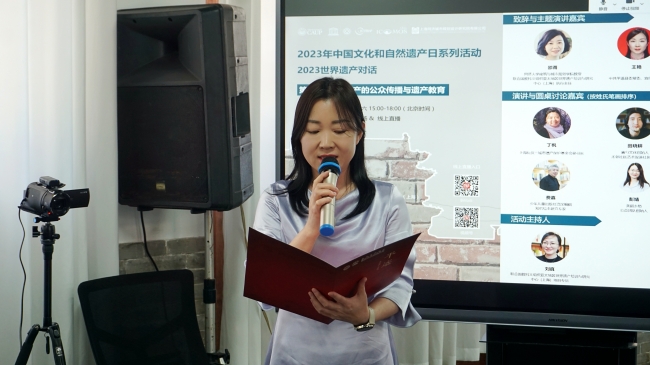 Ms. Wang Yan giving speech
02 | Keynote speeches
Jiang Bo, Vice President of the International Council on Monuments and Sites (ICOMOS), Deputy Director of ICOMOS China, and a Professor at Shandong University delivered a keynote speech titled "Historic Cities and Living Heritage". He made the following observations in his presentation:
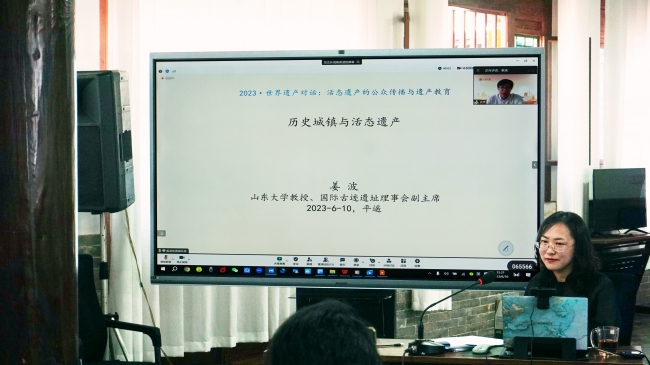 Prof. Jiang Bo giving speeching
Urban heritage is the crystallisation of human civilisation. Many historic cities are featured representatives of World Heritage Sites. China's World Heritage cities and towns have collectively reflected various forms of the oriental historic urban landscape. For example, the Ancient City of Pingyao represents the inland urban form of northern China; the Classical Gardens of Suzhou reflect the elegant and scholarly spirit of the Jiangnan region; the Lijiang Ancient Town is an important example of commercial town near the national border, where multiple ethnic groups coexist; Quanzhou Ancient City is a testament to China’s ancient maritime tradition; while the Central Axis of Beijing, which is under the nomination process for World Heritage List, is the most typical representation of the urban paradigm under Confucianism.
Functional Continuity is the Best Way to Protect living heritage. World Heritage sites cannot all become “museum exhibits”, and the continuation of their historic function is an important prerequisite for their continued vitality. For example, the Odeon of Herodes Atticus in Athens still serves as a concert hall today; the Liusheng Tower, which was historically used as a navigational beacon, requires the protection of the visual corridor between it and the sea. Conversely, Liverpool – a Maritime Mercantile City – was removed from the World Heritage List due to the development of large-scale sports facilities in the port; the historic railway station in Jinan, which was designed by a German architect in 1911, was demolished to make way for the new Jinan railway station.
Archives reflect the soul of a heritage site. Archives such as unearthed documents, historical images, and archaeological excavations often successfully reveal the historical development of World Heritage sites. For example, the oracle bones found at the Yin Ruins enabled the account of Shang Dynasty to become reliable and truthful; the 1869 photograph of the Parthenon served as an important reference for its conservation and the conservation of the Acropolis. The Getty Museum in the United States is a reconstruction of the Villa of Papyri in Herculaneum based on archaeological drawings and therefore has certain heritage values. The interpretation of heritage sites that have been separated from their original spatial and historical contexts (such as the Colosseum of Rome) relies particularly on historical archives.
Intangible heritage is often an integral part of heritage sites. Today’s heritage community continues to emphasize the integration of natural and cultural heritage, as well as tangible and intangible heritage. For example, the Temple of Heavenly Queen in Quanzhou, as a place of worship for the Goddess Mazu, carries historical beliefs and worship rituals that are highly valued by the local community; the “Tea Soul Stage” in Jingmai Mountain in Yunnan has witnessed worship rituals for ancestral tea farmers that continue to this day.
Historic towns and cities are of paramount importance in preserving living heritage. For example, the Pingyao Ancient City is a living heritage place with a vibrant local life that both belongs to the local people and conveys outstanding universal values to the world. For Lijiang Ancient City, it’s necessary to maintain its commercial prosperity in a way that respects the local historical significance. In Quanzhou’s World Cultural Heritage application process, the West Kaiyun Temple Street – as a unique street reflecting the character of the ancient city – was not extensively intervened due to the demand of experts, scholars and local residents, allowing it to become a historical urban space with profound cultural significance.
03 | Pecha-Kucha
After the keynote speech, six experts and professional practitioners shared their practices and observations in short talks. They are Mr Qi Xin, Editor-in-Chief of “World Heritage Weekly” of The People’s Daily (Overseas Edition); Mr Fei Jia, Senior Editor at Juvenile & Children’s Publishing House and renowned picture book expert; Mr Tian Xiaogeng, founder of Yishao Culture and Executive Director of Helin Community Art Promotion Society; Ms Ding Feng, Secretary General of Shanghai Ruan Yisan Urban Heritage Conservation Foundation; Ms Peng Jing, founder of the Beautiful Nostalgia Charity Team; and Ms Sun Yimeng, an illustrator based in France.
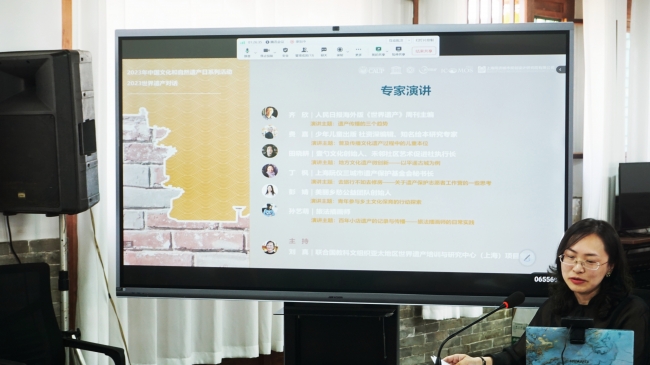 Ms. Liu Zhen introducing experts
· Three Trends in Heritage Communication / Qi Xin
Qi Xin believes that heritage communication is not only about “reporting” and “promotion” as it is traditionally understood, but has become a constructive tool for social relations and sustainable development. Heritage communication in today’s context requires common ground between localisation and globalisation. Based on this observation, Qi Xin identified three important trends in heritage communication in the time frame of the next 50 years: the promotion of understanding and respect on a global scale through mutual learning among civilisations; World Heritage as an innovative force that shapes and integrates our social life; and the deep integration of the cultural and natural heritage fields.
Qi Xin used Qinghai Lake National Nature Reserve as an example to discuss a variety of issues including the impact of climate change on the natural environment, public education in an era when the general public plays an important role in heritage communication, the ways to experience and promote national parks, public tourism routes, and the description and interpretation of the breath-taking values of natural heritage.
Qi Xin also introduced specific heritage communication cases such as Route 219, God’s Peak in Nonggang Nature Reserve, and the South China Sea, and showed methods of combining heritage communication strategies with cultural and natural heritage resources. He then introduced cases where young people in Asian countries have made efforts to protect their respective national heritage, emphasizing the importance of the participation of the younger generation.
Finally, Qi Xin suggested three changes that might occur in the narrative of the values of China’s World Heritage sites. First, the media for heritage communication will increasingly intersect, integrate and overlap. Second, the heritage communication ability of individuals, groups and organisations will increase iteratively. Third, the ability to interpret and describe the beauty of China’s cultural and natural heritage will be enhanced with the cooperation of more fields.
· The Promotion of Cultural Heritage Oriented by Children’s Perspective / Fei Jia
From the perspective of a publisher and educator working with children, Fei emphasizes that heritage communication should aim to intrigue children’s interest in knowing about and protecting cultural heritage. He shares his observations with three keywords: “simplified representation”, “incremental influence” and “learning by analogy”.
“Simplified Representation” refers to the idea that World Heritage sites can be represented by simple geometric shapes to accommodate the reading abilities of very young children. By pairing pyramids with triangles, courtyard residences (Siheyuan) with squares, and Fujian Tulou with circles, young children can learn to recognize shapes while becoming familiar with various cultural heritage sites around the world.
“Incremental Influence” involves delving into the details of cultural heritage sites once children have shown interest. For example, the forms of Chinese vernacular dwellings, their construction techniques, functions, and relevance to daily life can be introduced in more detail, promoting children’s deeper understanding of cultural heritage while they read for fun.
“Learning by Analogy” means that picture book illustrators should actively learn from each other and discover different ways of presenting cultural heritage. For example, a picture book on the history of local batik in Guangxi featured a batik craftsperson as the author and employed authentic wax-dying techniques in the production of the book. On the other hand, the I Grew Up in Pingyao series integrated cultural and historical contexts, and successfully attracted children’s interest by presenting both tangible heritage and underlying cultural traditions.
· Micro-Innovation of Local Cultural Heritage / Tian Xiaogeng
Tian Xiaogeng gave a brief presentation on the Pingyao Picture Book Project, a children-oriented art and heritage education project developed by Helin Art Society and Yishao Culture.
The Pingyao Picture Book Project consists of two components. First of all, the project gathered cultural experts to assess and interpret the values of local cultural heritage and engaged a group of artists to depict such values through the creation of a series of picture books that connect to the perspectives of children, which will be published after rounds of expert review and evaluation. Second, based on the stories told in these picture books, heritage education courses and extended public events will be organised to empower heritage education practitioners from Pingyao and a broader geographic background.
The Pingyao picture books aim to integrate tangible and intangible cultural heritage, connect the spirit of the ancient city with everyday stories, and reach out to schools in both the city and adjacent rural areas. Tian Xiaogeng hopes that through the project and its programmes, children will not only gain a perception and understanding of local cultural heritage but also strengthen cultural confidence and cultivate aesthetic and creative abilities.
· To Repair Old Houses, Instead of Traveling - Some Thoughts on Heritage Conservation Volunteer Camps / Ding Feng
Ding Feng introduced the Architectural Heritage Conservation and Restoration Workcamps jointly launched by Shanghai Ruan Yisan Urban Heritage Conservation Foundation and the REMPART Association of France. As the first public-oriented heritage volunteer workcamp in China, the programme was launched in Pingyao in 2011. So far, more than 32 workcamps have been held across China, involving more than 600 volunteers from China and other parts of the world.
The Heritage Volunteer Workcamp programme mainly targets the general public rather than heritage professionals. No relevant technical or professional background is required for volunteers, and participants from the local community are particularly welcome. The workcamps are always held in communities with historic buildings (especially those with heritage designation) in urgent need of repair and restoration. Over a period of 14 days, volunteers would donate their labour to the repair and restoration of heritage buildings under the guidance and instruction of local craftspeople. The workcamps also include visits to heritage sites, where volunteers can exchange culture and knowledge from their own countries or hometowns.
The hands-on conservation work during the workcamps has provided volunteers with a “tactile” experience of cultural heritage through actions such as touching, repairing, moving, and constructing. Such experience deepens participants’ memory of heritage sites and opens a new way for public communication of heritage conservation. The heritage volunteer workcamp has proven to be a popular and well-received heritage communication programme with a strong response from the public, as more and more people actively participate in volunteer work that enables them to better understand and conserve cultural heritage.
· Exploration of Youth Participation Mechanisms in Local Culture Heritage Conservation / Peng Jing
Peng Jing shared how the Beautiful Nostalgia Charity Team guides and empowers young people to participate in local cultural heritage conservation. As a university-based charity team, the Beautiful Nostalgia team is dedicated to the education and public communication of local cultural heritage and aims to cultivate the heritage of their hometown culture among youth and teenagers. They recognize that young people are also an important force in the conservation and communication of cultural heritage, but they lack empowerment and opportunities for action. In response, the Beautiful Nostalgia team proposed a full-cycle action plan of “local cultural research – local cultural education empowerment – local culture fostering and communication”.
On the front of local cultural research, the Beautiful Nostalgia team and WHITRAP Shanghai jointly launched the “Ripple Action: Hometown Chronicles” scheme, which has supported more than 2,000 volunteers from 420 universities across China to research the culture of their hometowns, resulting in the creation of a large number of “Hometown Chronicles” and various cultural products, drawing public attention to local cultural heritage observed from the perspective of young people. On the front of educational empowerment, they launched the “Ancient Village Heritage Inheritor Training Programme”, in which young volunteers lead local cultural heritage camps and events for children, stimulating community vitality. On the culture fostering and communication front, they launched the “Culture Lighting Up Villages” Plan, which encourages young people with professional skills to solve real problems in heritage communities and help revitalise the countryside and rural areas.
Through the full-cycle empowerment plan, the provision of toolkits, the development of resource networks, and the creation of various forms of participation, Beautiful Nostalgia has opened up a multi-layered participation scenario and established a path for the cultivating youth’s leadership in public charity and social work. The programmes have also continuously encouraged and supported the action and growth of the young generation, and cultivated talents for the cause of heritage conservation.
· Archiving and Promoting Century-Old Shops – The Daily Practice of an Illustrator Residing in France / Sun Yimeng
From the perspective of a freelance illustrator living in France, Sun Yimeng shared her observations on the communication of French cultural heritage and her own experience in creating heritage-themed picture books. During her time in France, Sun Yimeng realised that in addition to museums and famous landmarks, historic markets with unique characters are also significant heritage sites with important cultural values. She started to depict the lifestyle, cultural traditions and social changes of the local people by recording their daily life and various places of historical significance, which turned into the book Chaque Jour à Paris.
Later, she turned her attention to the century-old shops of Paris and created the picture book Boutiques Centenaires à Paris. While she was initially attracted to the exquisite storefronts of these shops, as she gradually learned about the stories and people behind each one, she discovered that these shops are actually gems of Paris, demonstrating French culture and craftsmanship.
Finally, as an illustrator, she found that recording these small shops in her daily practice and presenting historical culture through illustration served as part of her professional and personal growth in the cultural environment in which she lives. Posting illustrations and stories of century-old shops on social media and publishing picture books have facilitated the public’s understanding of the cultural heritage behind these shops, and serve as a way for illustration art to contribute to the communication of urban culture.
04 | Roundtable Discussion
In the roundtable discussion section, Prof. Shao Yong – as the moderator – raised the keywords “heritage” and “communication”, and proposed “the biggest difficulty in public communication of cultural heritage” as the key issue for discussion. Speakers and experts who participated in the dialogue responded based on their professional perspectives and practical experiences.
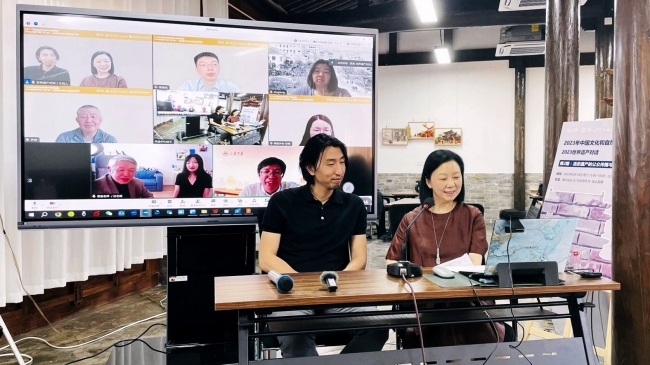 Round table
Yan Haiming, Deputy Director and Researcher at the China World Cultural Heritage Research Centre, China Academy of Cultural Heritage, and Director of the Secretariat of ICOMOS China, believes that the biggest difficulty in the public communication of cultural heritage is that it’s hard to find patterns of successful practice. Communicators of cultural heritage already know that they should tell stories from the public’s perspective and that they should try different ways to tell good stories. However, public reception and the impact of communication are often unpredictable, making it difficult to synthesize patterns of successful and unsuccessful practices. Therefore, communicators of cultural heritage need to strengthen learning and knowledge sharing with communication professionals and build synergy for heritage communication.
Prof. Jiang Bo believes that in the face of World Heritage and cultural heritage, the most difficult issue is to determine one’s attitude. He has been an advocate of “respect for heritage”. He pointed out that many heritage promotion events aimed at youth and teenagers simply broadcast simplified narratives originally intended for adults, which is not the appropriate approach. He emphasized that we should interpret world heritage from children’s perspective, and their understanding of images and symbols.
Qi Xin feels that the biggest challenge is that he wonders “who he is” as many industries do not currently have the position of professional communicator, and it is sometimes hard for him to know where his position is or how to move forward. He feels that he is romantic but lonely in the field of cultural heritage communication, and he urges more people to think about how Chinese people can gain respect in the world from the perspective of cultural heritage and to imagine how cultural heritage can continue to thrive.
Ding Feng believes that the difficulty of heritage conservation and public communication lies in persistence. Heritage conservation is a small field, whether in China or the world. Therefore, passion and romance are necessary. She believes that she is not alone in this journey as she is persistent in her efforts and that because everyone loves their hometown and culture, the public is very willing to participate in heritage conservation once there’s the right opportunity – there may simply be too few opportunities for them to get involved before. She believes that by creating the right opportunities for more groups of people, including children and the elderly, public participation in heritage conservation would be strengthened.
Peng Jing noted that the biggest difficulty is to secure enough support and advocacy at every step of the youth’s efforts in heritage communication. She hopes that more young people will join the cause of heritage communication, that they’ll be able to find suitable tutors and advisors from different backgrounds, that there will be more partners to support their practice, experience and growth, and that there will be a larger network that allows young heritage communicators and their efforts to be seen so that they can be encouraged to persevere in the heritage communication endeavour. Building a broader network and obtaining more resources and support have always been key difficulties in the field.
Fei Jia believes that heritage conservation is a multifaceted cause, and the difficulty and key issue lies in developing a cultural heritage education system that starts with children. He believes that children should be encouraged to visit museums, art galleries and various heritage sites, not only to receive lessons, but also to experience cultural heritage as an integral part of their daily lives, and to gradually form a comprehensive cognition and perception of cultural heritage.
Sun Yimeng faced challenges when exploring and identifying the significant cultural values and underlying stories behind heritage sites. Such ability is a new requirement for her as an illustrator and something she needs to learn in the future. She notes that her practice is not just about illustrating physical places, but more about exploring the people behind those places with their lives, memories and emotions.
Tian Xiaogeng doesn’t think there are any major difficulties. Instead, he sees many opportunities. He believes that there are a large number of respectable frontline educators working in both cities and the countryside. They may be ordinary, but they are all concerned about heritage education and art education. It has always been the priority of the Helin Art Society to bring these people together so that they don’t feel alone and can get more support and energy.
Prof. Shao made insightful remarks in response to each speaker’s comments.
The final part of the dialogue features interaction with the online and in-person audiences. In response to the online audience’s question about the motivations of Ripple Action volunteers, Peng Jing noted that everyone has a connection to their hometown and that through Ripple Action programmes, participants have strengthened their cultural identity and promoted cultural self-confidence. On the other hand, the stimulation and maintenance of participants’ passion is also related to the project itself, which is designed to make participants feel supported and grow, as well as provide feasible ways for participation.
The second question from the audience is "How to identify core communities in the conservation of Pingyao’s living heritage”. Yan Haiming believes that first and foremost, it is important to facilitate a paradigm shift that focuses on the role of people in heritage conservation, which refers to the people-oriented concept that has long been established in China’s heritage conservation practice. From a practical point of view, there is still a huge gap between the theory and practice of living heritage conservation, especially concerning the conservation of historic cities, towns and villages and their connection with the daily lives of local people. Therefore, plans, strategies and policies should be developed based on a thorough understanding of the local community’s real perceptions of cultural heritage, as this is the only way we can coordinate the interests of different stakeholders. As an expert with a background in sociology, he believes that heritage conservation practice should insist on engaging as many stakeholders as possible, and strive to promote mutual understanding and find common ground among these stakeholders.
Prof. Jiang Bo pointed out that an important factor considered in the evaluation process for World Heritage nominations is the attitude of the local community towards the potential World Heritage status, which should not have a negative impact on the local lifestyle and ecology. The continuation of heritage functions is particularly important, as heritage sites should not be turned into lifeless exhibits; instead, the livelihoods and lifestyles of local people should be respected.
Prof. Shao Yong commented that the “core community” includes two types of community members: one is “rights holders”, namely those who exercise direct legal rights over the heritage site, such as property owners; the other is “stakeholders”, including tenants, merchants, heritage managers and experts. A successful conservation scheme should be able to engage both rights holders and stakeholders at the same time. She noted that she is developing a deeper understanding of the public nature of heritage places as she continues to work on the conservation of Pingyao Ancient City. As a living heritage site, Pingyao still accommodates a large number of residents. Therefore, the convenience of their lives has to be balanced with the authenticity and integrity of the heritage city. More consensus needs to be reached on how to meet the requirements of heritage protection and how to make contemporary residents enjoy living and working in the Ancient City.
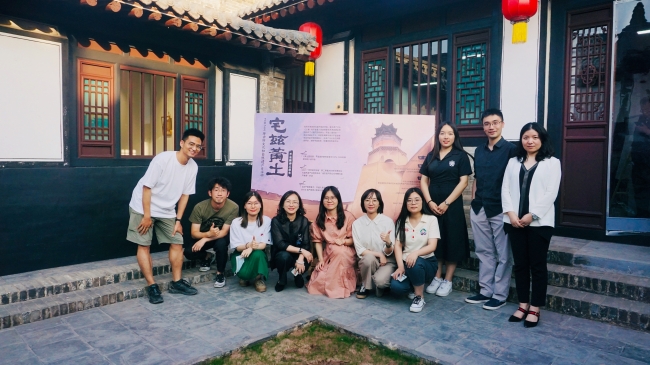 Group photo of Tongji work team and volunteers from Shanxi University
Contributed by Wang Ziming (intern), Zhang Mingmin (intern), WHITRAP Shanghai
Cui Jiaying, Xiong Xiangying, Zhang Xiaoyan, College of Architecture and Urban Planning, Tongji University
Chen Yiwei, Wang Jiaqi, Gao Yang, Fu Ning, Shanxi University
Translated by Zheng Shizhe (intern), Wang Ziming (intern), WHITRAP Shanghai
Typeset by Wang Yuxuan (intern)
|
- News | WHITRAP Shanghai and CNR-ISPC bilateral meeting
- News | WHITRAP meets Cité de l’Architecture et du Patrimoine
- WHITRAP Hosting "Workshop on Preliminary Assessment for National Focal Points of the Asia Region" in Chengdu
- WHITRAP Shanghai meets UNESCO
- INTERNATIONAL CONFERENCE PRELIMINARY ANNOUNCEMENT & CALL FOR PAPERS
- Observation of the 46th Session of the World Heritage Committee
Copyright © 2009-2012 World Heritage Institute of Training and Research-Asia and Pacific (shanghai)


